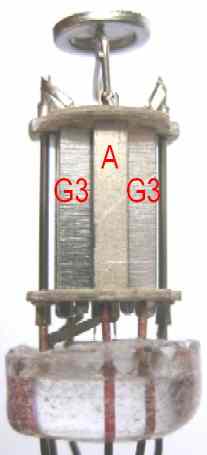6j45b-v (6j45b-v) dissected
6j45b-v (6j45b-v) dissected
This pentode has a grooved bulb and it is difficult to identify the construction. A similar construction with rods instead of wire grids seems possible.
Together with the last tube delivery one 6Ж45Б-В came broken. I opened it and made pictures and measurements with a slide gauge and a feeler gauge as far as I could.
The system ist built mirror-inverted except for the catode in the center. .png)
All system parts have an electrical height of 8 mm. G2, G3 and Plate are flat of 0.25 mm gauge. G2 and G3 are magnetic, not so the plate.
The plate is a rectangle 1.6 mm wide, the gap to G3 is 0.6 mm.
G3 is a frame 4.7 mm wide, the window is 1.6 x 6.4 mm, the gap to G2 is 0.35 mm.
G2 is a frame of 4.9 mm, the window is 1.6 x 6.4 mm with 28 grid wires against the inner side.
G1 is a cap profile frame of 2.8 x 0.4 mm, the window is 1.3 x 6.3 mm with ca. 70 wires against the inner side.
Cathode measures 1.2 x 0.8 mm



To thank the Author because you find the post helpful or well done.
Is g1 fine wire mesh? It's hard to tell from photo. It's interesting and looks a little like a hybrid of rod tube and "regular" valve. But I'm not sure exactly what I'm looking at.
I've seen various sellers (not all eBay) with Russian valves that seem unusual. Western development seems to have ground to a halt in late 1950s with little Domestic change after 1955. Of course most of these unusual Russian types (with possibly development up to mid 1970s) are for military only.
The 1p24b-v also has a grooved tube.
The grooves make a lot of reflections!
To thank the Author because you find the post helpful or well done.
6j45b-v grid construction
G1 isn't fine mesh, it's around 70 fine wires in parallel over the window.
The g1-frame is mounted close to the catode. In the picture below you can see the outpopped G1 and the catode with "G1 footprint" in the coating.
Only g3 is without wires, just the window. It seems like a "beam (power) pentode", but unlike to beam power tetrodes, G1 and G2 don't have identical grid wiring and G3 is separately lead through instead of beeing connected directly to the catode.

To thank the Author because you find the post helpful or well done.
Beam Tetrodes vs Pentodes
Thanks,
Maybe what you call a Mesh I'd call perforations :-)
OK, so the G1 grid wires, a kind of fine "mesh" in one direction. I see a few valves where G2 is a looser mesh or wire coil than G1.
An RF beam tetrode may indeed bring out the G3 separate. For ordinary Pentode / Beam tetrode application in "common cathode" mode it's safe to internally connect G3.
But if you use the valve in common grid with drive to cathode then internal G3 to Cathode would make an oscillator. In such a case the G3 is connected to RF ground. (might not actually be 0V).
So a separate G3 connection on a Pentode or Beam tetrode always suggests possible RF application and gives the greatest flexibility. I've never analysed Common Anode (also more usually called Cathode follower) if G3 connected to Cathode is a problem. It's likely not ideal.
This is I think a good article on Beam Tetrode and Pentode
The ECL82 (PCL82) and ECL86 (PCL86) are in fact really Triode and Beam Tetrode in one tube, not a regular Pentode. The EF86 Pentode has of course G3 on separate connection for most flexibility of use such as even common Grid mode.
So the 6j45b does look to me like the "beam tetrode" family of Pentode, and not too many of those I think have the "beam plates" (usually referred as g3) to a separate connection. The rod pentodes show though that the Russian designers experts on electrostatic focus, and the the beam forming plates I think work a similar way to G3 in rod Pentode as those are to side of the beam, and the Rod Pentodes also have twin beams and two anodes.
I believe the DL92 B7G miniature Pentode has no G3 wires, but also is in reality a Beam Tetrode.
To thank the Author because you find the post helpful or well done.